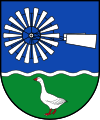In heraldry, argent is the tincture of silver, and belongs to the class of light tinctures called "metals". It is very frequently depicted as white and usually considered interchangeable with it. In engravings and line drawings, regions to be tinctured argent are either left blank, or indicated with the abbreviation ar.
In heraldry, gules is the tincture with the colour red. It is one of the class of five dark tinctures called "colours", the others being azure (blue), sable (black), vert (green) and purpure (purple).
In heraldry, purpure is a tincture, equivalent to the colour purple, and is one of the five main or most usually used colours. It may be portrayed in engravings by a series of parallel lines at a 45-degree angle running from upper right to lower left from the point of view of an observer, or else indicated by the abbreviation purp.
In heraldry, tenné is a "stain", or non-standard tincture, of orange, light brown or orange-tawny colour.

Tincture is the limited palette of colours and patterns used in heraldry. The need to define, depict, and correctly blazon the various tinctures is one of the most important aspects of heraldic art and design.

In heraldry, variations of the field are any of a number of ways that a field may be covered with a pattern, rather than a flat tincture or a simple division of the field.
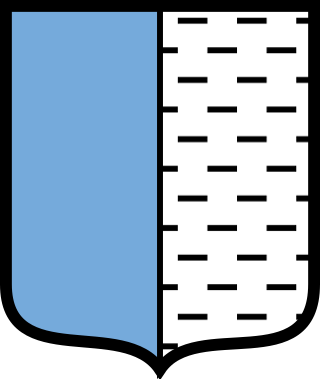
Bleu celeste is a rarely occurring and non-standard tincture in heraldry. This tincture is sometimes also called ciel or simply celeste. It is depicted in a lighter shade than the range of shades of the more traditional tincture azure, which is the standard blue used in heraldry.
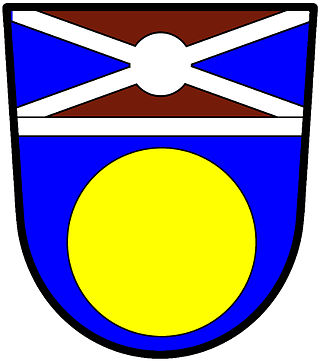
In heraldry, murrey is a "stain", i. e. a non-standard tincture, that is a dark reddish purple colour. It is most proximate in appearance to the heraldic tincture of purpure, but is distinct therefrom.

Azure is the color between cyan and blue on the spectrum of visible light. It is often described as the color of the sky on a clear day.
In British heraldry, sable is the tincture equivalent to black. It is one of the five dark tinctures called colours.
In heraldry, or is the tincture of gold and, together with argent (silver), belongs to the class of light tinctures called "metals". In engravings and line drawings, it is hatched using a field of evenly spaced dots. It is very frequently depicted as yellow, though gold leaf was used in many illuminated manuscripts and more extravagant rolls of arms.
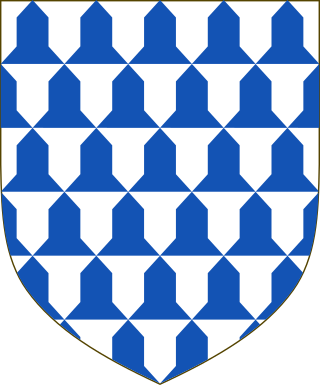
Vair, originating as a processed form of squirrel fur, gave its name to a set of different patterns used in heraldry. Heraldic vair represents a kind of fur common in the Middle Ages, made from pieces of the greyish-blue backs of squirrels sewn together with pieces of the animals' white underbellies. Vair is the second-most common fur in heraldry, after ermine.
Light blue is a color or range of colors, typically a lightened shade with a hue between cyan and blue.

The rule of tincture is a design philosophy found in some heraldic traditions that states "metal should not be put on metal, nor colour on colour". Heraldic furs such as ermine and vair, and charges described as "proper", are generally exempt from the rule of tincture.
In British heraldry, vert is the tincture equivalent to green. It is one of the five dark tinctures called colours.

In heraldry and heraldic vexillology, a blazon is a formal description of a coat of arms, flag or similar emblem, from which the reader can reconstruct the appropriate image. The verb to blazon means to create such a description. The visual depiction of a coat of arms or flag has traditionally had considerable latitude in design, but a verbal blazon specifies the essentially distinctive elements. A coat of arms or flag is therefore primarily defined not by a picture but rather by the wording of its blazon. Blazon is also the specialized language in which a blazon is written, and, as a verb, the act of writing such a description. Blazonry is the art, craft or practice of creating a blazon. The language employed in blazonry has its own vocabulary, grammar and syntax, which becomes essential for comprehension when blazoning a complex coat of arms.

The color cyan, a greenish-blue, has notable tints and shades. It is one of the subtractive primary colors along with magenta, and yellow.

Sky blue refers to a collection of shades comparable to that of a clear daytime sky. Typically it is a shade of cyan or light teal, though some iterations are closer to light blue. The term is attested from 1681. A 1585 translation of Nicolas de Nicolay's 1576 Les navigations, peregrinations et voyages faicts en la Turquie includes "the tulbant [turban] of the merchant must be skie coloured".
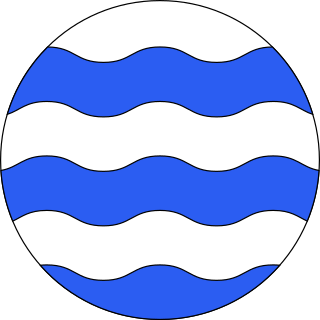
Fountain or syke is in the terminology of heraldry a roundel depicted as a roundel barry wavy argent and azure, that is, containing alternating horizontal wavy bands of silver and blue. Traditionally, there are six bands: three of each tincture.

A roundel is a circular charge in heraldry. Roundels are among the oldest charges used in coats of arms, dating from the start of the age of heraldry in Europe, circa 1200–1215. Roundels are typically a solid colour but may be charged with an item or be any of the furs used in heraldry. Roundels are similar to the annulet, which some heralds would refer to as a false roundel.


